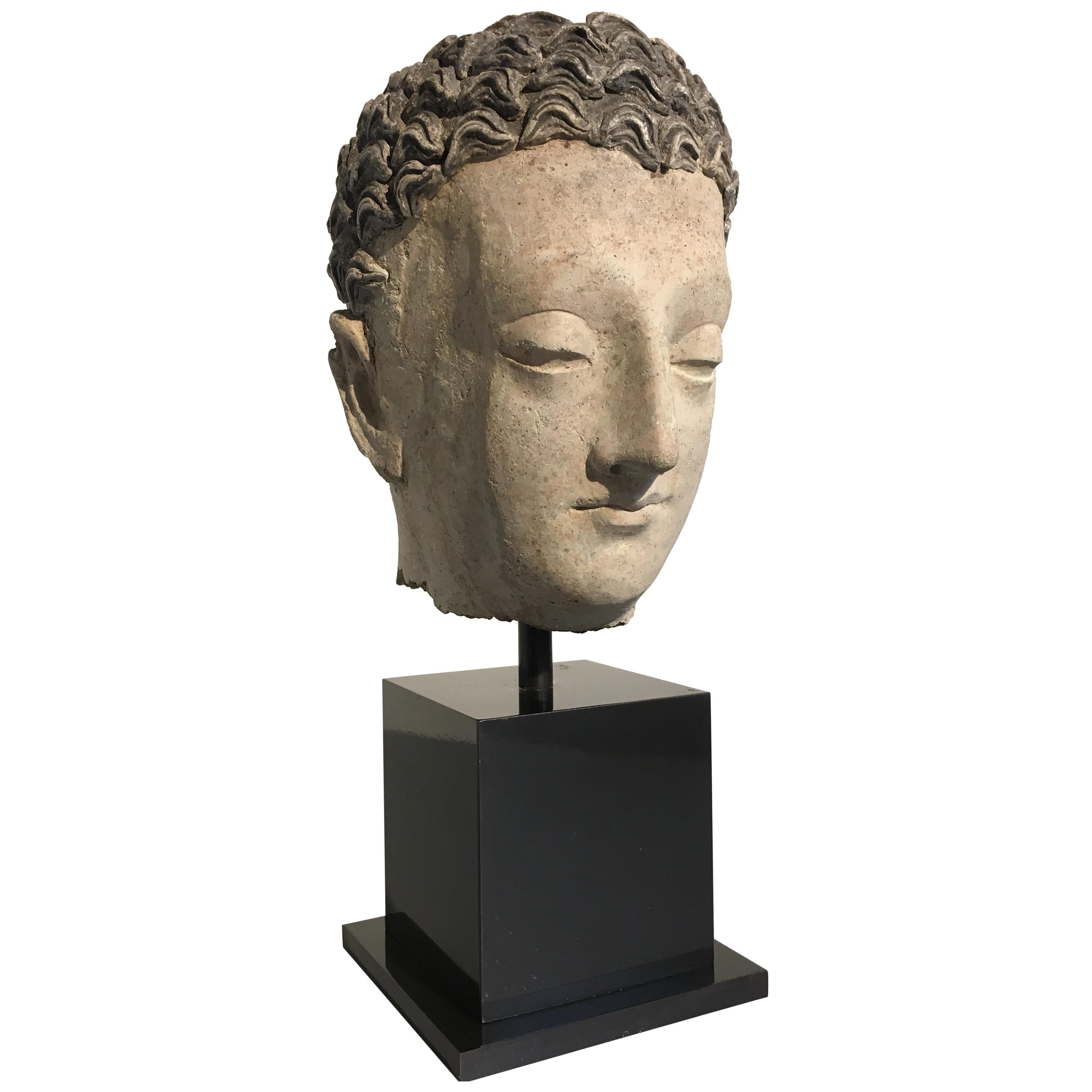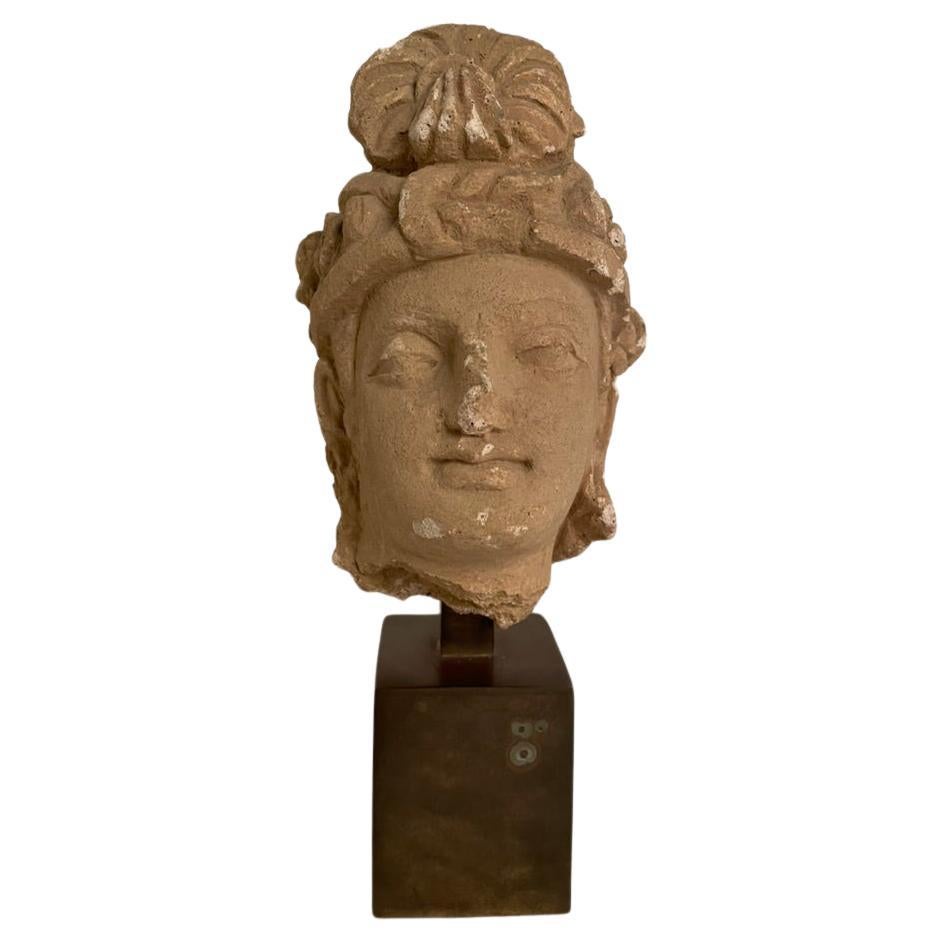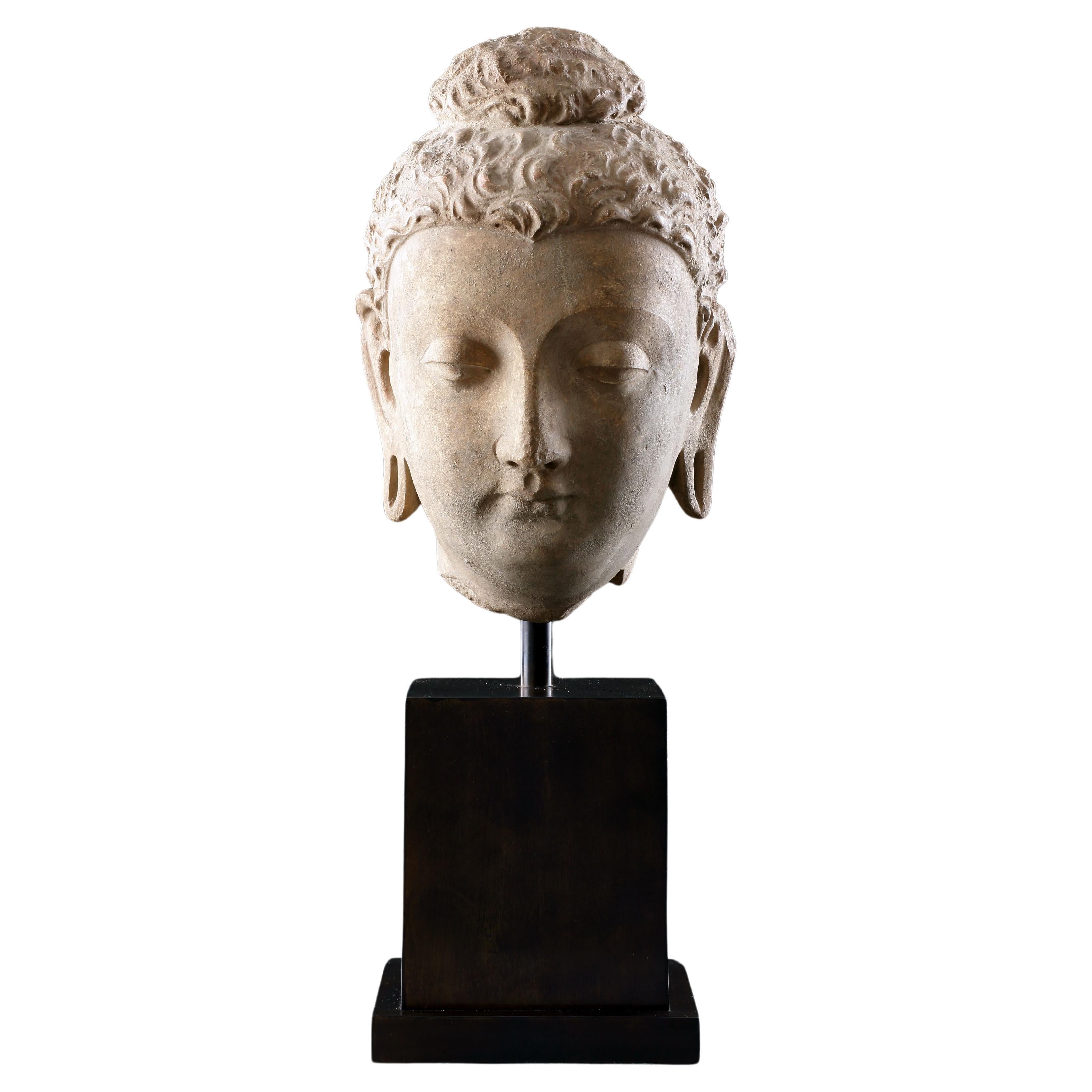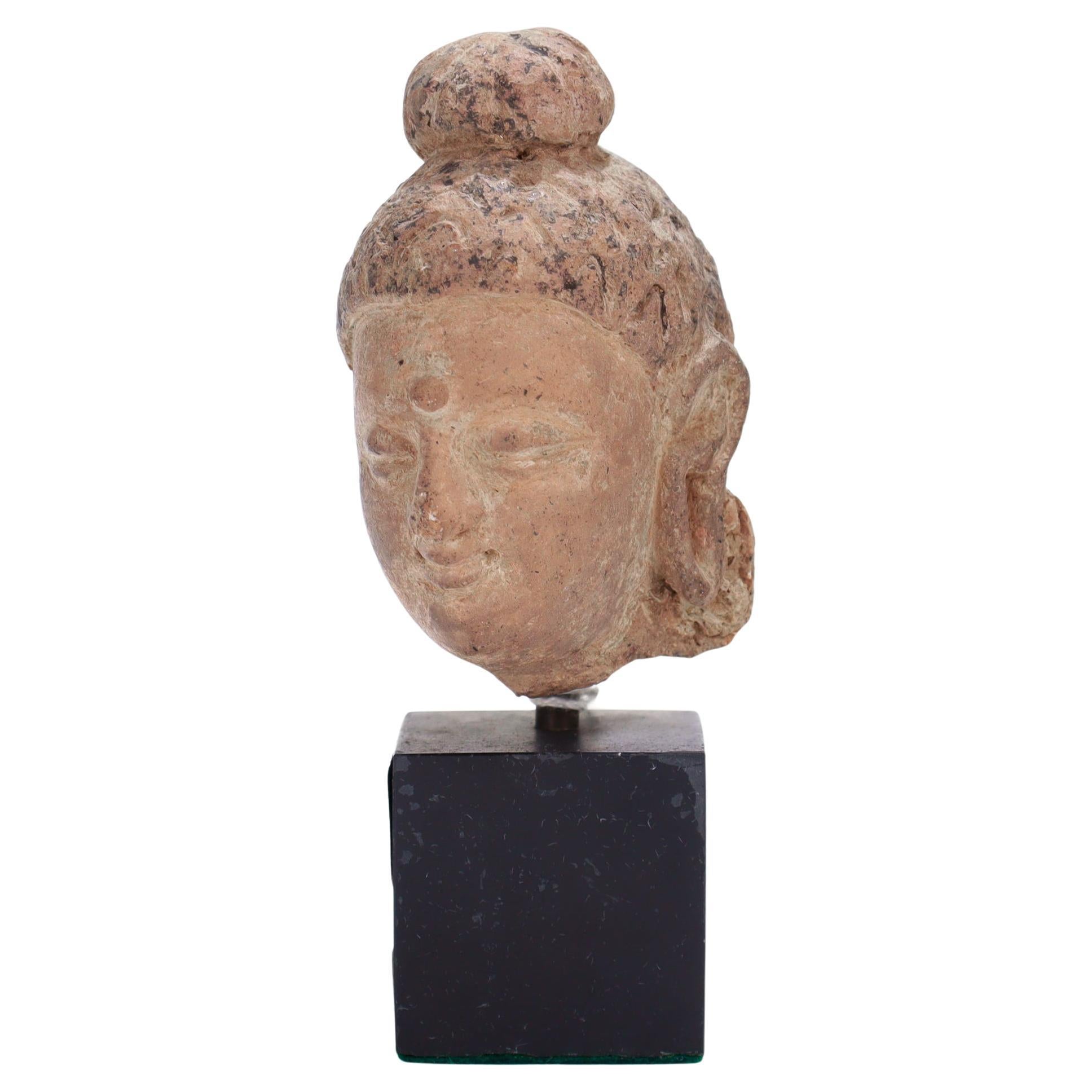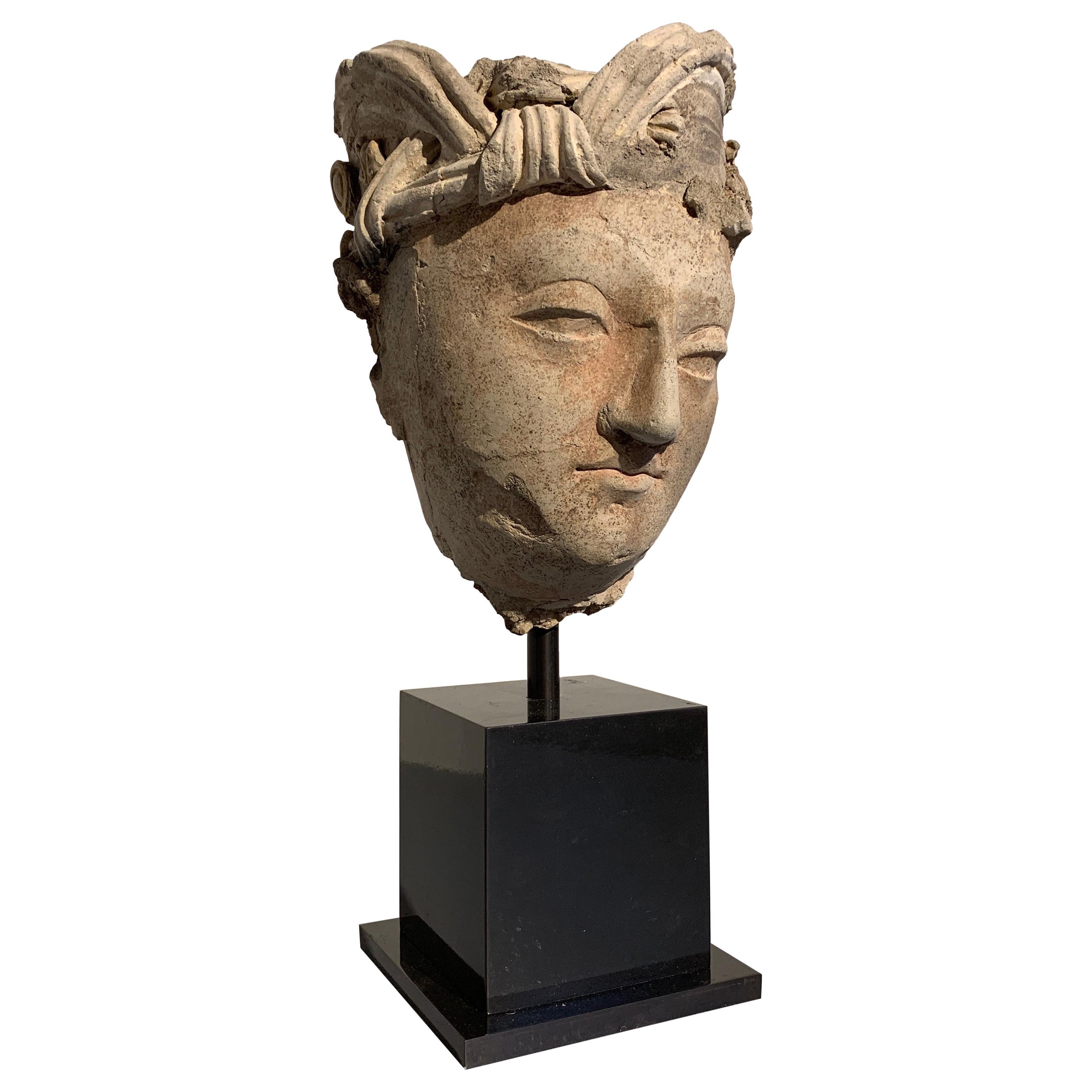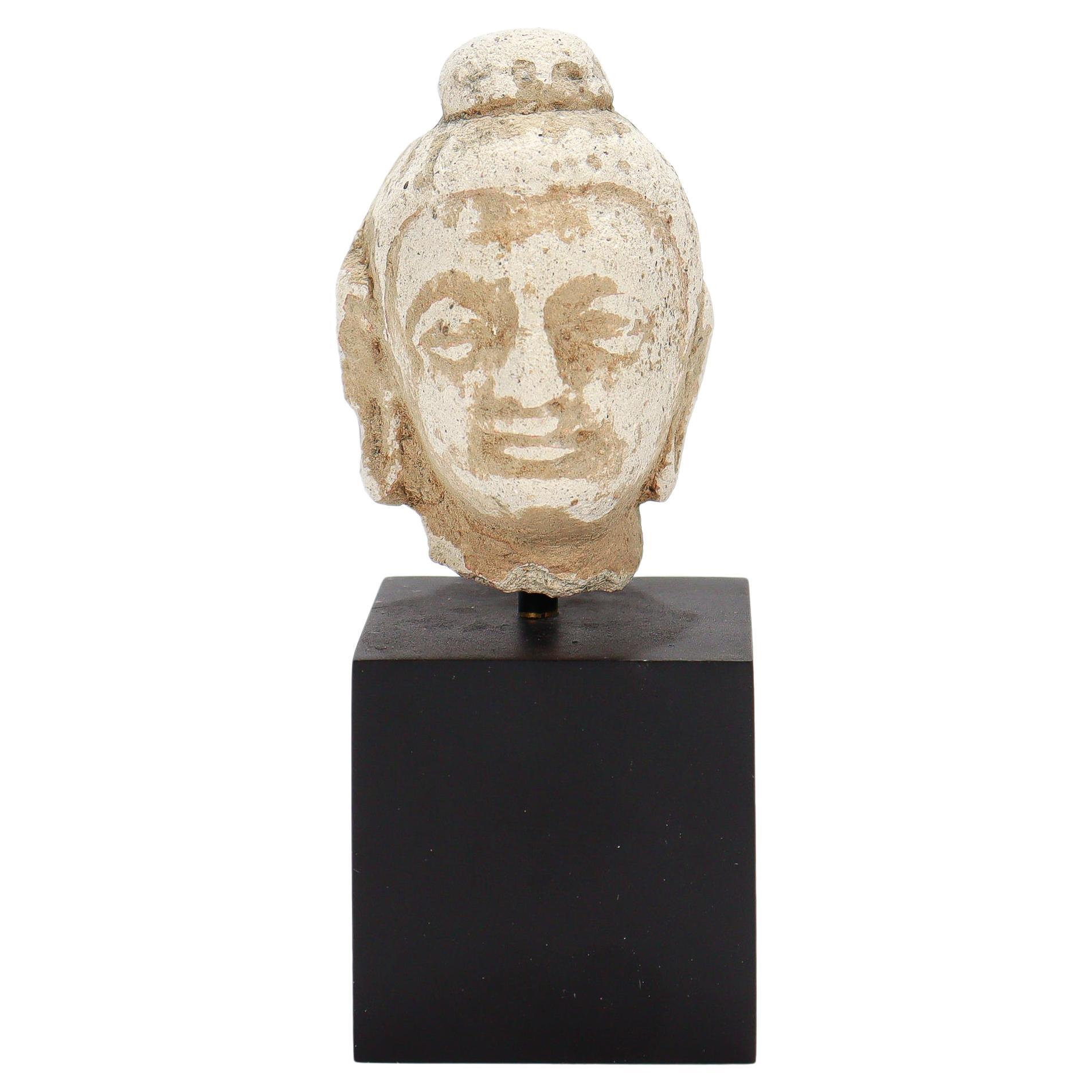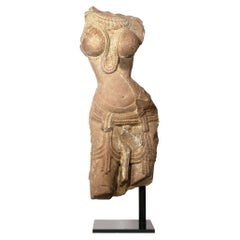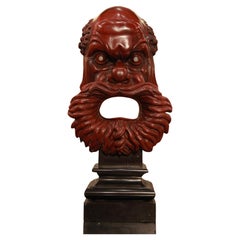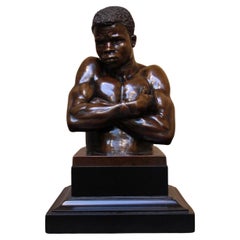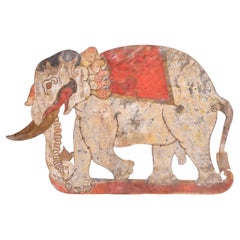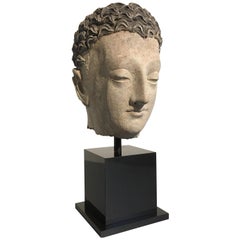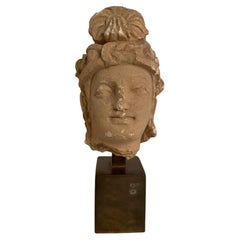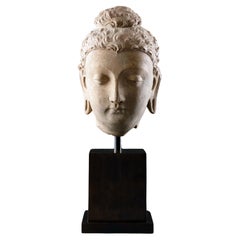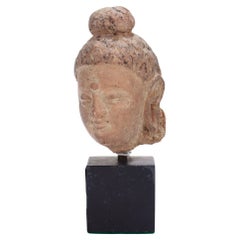Items Similar to Gandharan Head of Buddha Grey Schist, 3rd to 4th Century
Want more images or videos?
Request additional images or videos from the seller
1 of 5
Gandharan Head of Buddha Grey Schist, 3rd to 4th Century
$42,730.09
£31,200
€36,656.17
CA$59,931.08
A$65,728.49
CHF 33,898.93
MX$785,182.41
NOK 429,941.57
SEK 403,333.97
DKK 273,848.57
About the Item
The style of this sculpture points to its having been carved in the mature period of the 3rd to the 4th centuries when there was a smooth transition in the planes of the face which were longer and often oval in shape. Gandhara was the name for the Peshawar valley in what is now Pakistan and the name Gandhara is found in Vedic Sanskrit writing of the 2nd century BC. However the term Gandhara is also used to describe a style of sculpture which is found over a larger area which encompasses parts of the Hindu Kush, Afghanistan and Peshawar in Pakistan. The area was very important because of its geographical location; the rivers Kabul and Swat with their many tributaries joined and flowed together with further tributaries and rivers into the Indus. The wide valleys surrounding these waterways together with their location on the edge of the monsoon has supported, since pre-historic times, substantial agricultural communities and urban centres. This large area has been transited by many trade routes; through the mountain ranges of the Hindu Kush and the Himalayas to India in the South, the east-west route through the Hindu Kush, and the northern route along the Swat. Because of this geographical importance it was invaded numerous times including by the Iranian Achaemenid empire which was itself conquered by Alexander the Great in the 4th century B.C. Although Alexander had to abandon his advance in this area and it was absorbed into the earliest Indian empire (324-187 BC) there remained Greek settlers and rulers in parts of Gandhara until the beginning of the first century. (Numismatic evidence) The Buddhist expression of Gandharan art is the most well known and dates from the 1st century BC through the next 500 to 600 years and although scholars are still debating the importance of various influences in the area which was conquered many times, it is accepted that there is an obvious Graeco-Roman aspect to the sculpture. Of undoubted importance to the increasing popularity of Buddhism in the area and a probable influence on its style of art was the patronage of the Indo Greek king Menander who established an Empire in the 2nd century BC and may even have been a convert (his fascination with the cult is known and he is remembered in Buddhist literature as having discussions with the Buddhist sage Nagasena). Over the next few hundred years Buddhism was increasingly adopted in the area and it grew to become a Holy Land with religious foundations and places of pilgrimage.
Provenance: an old private collection in France Bibliography: A Catalogue of the Gandharan Sculpture in the British Museum by W. Zwalf Vol.II Plates 40 to 43
Dimensions:
42cm tall (including stand)
21cm wide
22cm deep
- Dimensions:Height: 16.93 in (43 cm)Width: 7.49 in (19 cm)Depth: 8.67 in (22 cm)
- Materials and Techniques:
- Place of Origin:
- Period:
- Date of Manufacture:3rd to 4th Century
- Condition:Wear consistent with age and use. Good.
- Seller Location:London, GB
- Reference Number:1stDibs: LU10128246976852
About the Seller
No Reviews Yet
Vetted Professional Seller
Every seller passes strict standards for authenticity and reliability
1stDibs seller since 2024
- ShippingRetrieving quote...Shipping from: London, United Kingdom
- Return Policy
Authenticity Guarantee
In the unlikely event there’s an issue with an item’s authenticity, contact us within 1 year for a full refund. DetailsMoney-Back Guarantee
If your item is not as described, is damaged in transit, or does not arrive, contact us within 7 days for a full refund. Details24-Hour Cancellation
You have a 24-hour grace period in which to reconsider your purchase, with no questions asked.Vetted Professional Sellers
Our world-class sellers must adhere to strict standards for service and quality, maintaining the integrity of our listings.Price-Match Guarantee
If you find that a seller listed the same item for a lower price elsewhere, we’ll match it.Trusted Global Delivery
Our best-in-class carrier network provides specialized shipping options worldwide, including custom delivery.More From This Seller
View AllAn Indian Red Sandstone Torso of a Devata – 10th/11th Century
Located in London, GB
An Indian Red Sandstone Torso of a Devata, Probably Rajasthan, the female deity depicted in tribhanga, her voluptuous body adorned with elaborate jewellery, wearing a sheer dhoti sec...
Category
Antique 15th Century and Earlier Indian Figurative Sculptures
Materials
Sandstone
Rare Carved Rosso Antico Mask In The Manner Of Benedetto Boschetti (1820-1860)
Located in London, GB
The mask or ‘mascaron’ of Greek theatrical form, set on a polished black marble base overall height 56cm, base 18cm wide, 13.5cm deep Provenance: Daniel Katz Ltd. London, where purch...
Category
Antique Late 19th Century Italian Figurative Sculptures
Materials
Belgian Black Marble
Shangaan Bronze Bust by Anton van Wouw, 1907
Located in London, GB
Shangaan Bronze Bust by Anton van Wouw, 1907 – Powerful Portrait of a Migrant Labourer Cast by G. Nisini, Rome.
bronze 30cm by 20c, by 15cm (including base)
...
Category
Antique Early 1900s English Busts
Materials
Bronze
An Indonesian Wayang Kulit Shadow Puppet of Gajah (Elephant)
Located in London, GB
An Indonesian Wayang Kulit Shadow Puppet of Gajah (Elephant), Java, Indonesia, South East Asia, late 19th – early 20th century
Opaque pigments heightened in gold on hide, designed i...
Category
Early 20th Century Indonesian Animal Sculptures
Materials
Hide
Shangaan Bronze Bust by Anton van Wouw, 1907 – Powerful Portrait
By Anton van Wouw
Located in London, GB
Shangaan Bronze Bust by Anton van Wouw, 1907 – Powerful Portrait of a Migrant Labourer Cast by G. Nisini, Rome – inscribed ‘Anton van Wouw /
bronze 30cm by 20c, by 15cm (including...
Category
Early 20th Century Dutch Busts
Materials
Bronze
A Greek marble funerary stele
Located in London, GB
A Greek marble funerary stele, In the form of a naiskos, the pediment with central roundel and acroteria at the corners, with a scene carved in high relie...
Category
Antique 15th Century and Earlier Greek Historical Memorabilia
Materials
Marble
You May Also Like
Gandharan Stucco Head of the Buddha, 3rd-5th Century
Located in Austin, TX
A sublime Greco-Buddhist stucco head of the Buddha, ancient region of Gandhara, circa 3rd-5th century.
A fragment of a larger statue, the Buddha's face...
Category
Antique 15th Century and Earlier Pakistani Figurative Sculptures
Materials
Stucco
Gandharan Stucco Head of a Bodhisattva, 3rd-5th Century
Located in Stamford, CT
Stucco head of a Bodhisattva, Gandhara, 3rd - 5th century AD. Mounted on a custom made brass base.
12 inches high ( head alone 8.2 in ) 5.5 wide 5 deep
Provanance: Ex Sotheby's, old...
Category
Antique 15th Century and Earlier Sculptures and Carvings
Materials
Stucco
A Fine Gandharan Head of a Buddha
Located in London, GB
A Fine Gandharan Head of a Buddha
Stucco with ‘earth pigment’
Some old ‘restoration’ to the nose
Afghanistan
3rd Century AD
Size: 26cm high, 14.5cm...
Category
Antique 15th Century and Earlier Afghan Antiquities
Materials
Stucco
Ancient Gandharan Miniature Stucco Bust of the Buddha, ca. 5th Century
Located in Philadelphia, PA
A fine ancient stucco bust on a plinth.
In the form of the Buddha, Siddhartha Gautama.
Mounted on a black wooden plinth.
Retaining an old Stair Galleries auction label and collect...
Category
Antique 15th Century and Earlier Indian Sculptures and Carvings
Materials
Terracotta, Stucco
Gandharan Stucco Head of a Bodhisattva, Region of Hadda, 3rd-5th Century
Located in Austin, TX
A striking Gandharan molded stucco head of a male Bodhisattva, tentatively identified as Manjushri, ancient region of Gandhara, probably Hadda or surrounding area, 3rd-5th century.
The Bodhisattva is sculpted of stucco in an idealized manner as a youthful male, with soft and kind features, a benign expression on his face. He wears an elaborate pleated turban wrapped around his head, with two sweeping lobes at the front.
His turban secured on one side by a small image of a roaring lion. The lion may be read as a reference to Manjushri, the Bodhisattva of Wisdom, who is often depicted as riding or subduing a roaring lion, a metaphor for taming the wild thoughts of the mind.
Manjushri gazes outwards in a beatific manner from almond shaped eyes, a gentle smile on his lips. The eyes at different levels when looking at the sculpture head on, indicating the original placement of the head was meant to be viewed at an angle.
Remnants of pigments to the eyes, nose, mouth and ears.
Mounted on a custom black metal stand.
Hadda was an important center of Buddhist learning in the early history of Greco Buddhist Gandhara, and at one time may have housed a bone relic of the historical Buddha, Shakyamuni. The sculpture and architecture of Hadda followed Hellenistic artistic conventions faithfully, leading some scholars to believe the distinct Greco Buddhist style of Gandhara was first developed in Hadda before spreading to the rest of the region.
The kingdom of Gandhara was situated at a crossroads of trade and cultures. Being one of the last remnants of Alexander the Great's Empire, the inhabitants of the Greco-Bactrian Buddhist kingdom preserved Greek culture and heritage for centuries after the decline of the Greek Empire...
Category
Antique 15th Century and Earlier Afghan Hellenistic Sculptures and Carvings
Materials
Stucco
Ancient Gandharan Stucco Small Bust of the Buddha or Bodhisattva
Located in Philadelphia, PA
A fine ancient figural bust.
In stucco on terracotta.
In the form of the Buddha or a bodhisattva (possibly Avalokiteśvara/Guanyin).
Mounted on a black wooden plinth.
Simply a won...
Category
Antique 15th Century and Earlier Indian Sculptures and Carvings
Materials
Terracotta, Stucco
